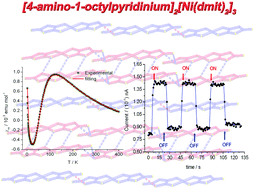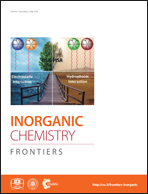Experimental and theoretical investigation of the magnetic and photoconductive nature of a novel two-dimensional, mixed-valence bis(2-thioxo-1,3-dithiole-4,5-dithiolato)nickelate molecular solid†
Abstract
A two-dimensional, mixed-valence [Ni(dmit)2] compound, [C8-Apy]2[Ni(dmit)2]3 (1) (where dmit2− = 2-thioxo-1,3-dithiole-4,5-dithiolate and Apy+ = 4-amino-1-alkylpyridinium), was prepared and its structure was fully characterized. The molecular solid displays a layered structure along the crystallographic c-axis with a [Ni(dmit)2] layer constructed from alternating straight chains of [Ni(dmit)2]0 and two-legged ladder chains of [Ni(dmit)2]1−. Compound 1 shows an antiferromagnetic, spin-dimer with pairwise interaction magnetic behavior and a semiconducting nature in addition to a rapid, clear and stable response of photoconductivity under UV irradiation. The magnetic coupling nature of 1 was analyzed using the ‘broken-symmetry’ density functional theory (DFT) approach. The electronic band structure was calculated using the CASTEP program and was used to investigate the theoretical transport and photoconductive behavior of 1. This work suggests that mixed-valence [Ni(dmit)2] compounds have great potential as the building blocks for new photoconductor based materials.


 Please wait while we load your content...
Please wait while we load your content...